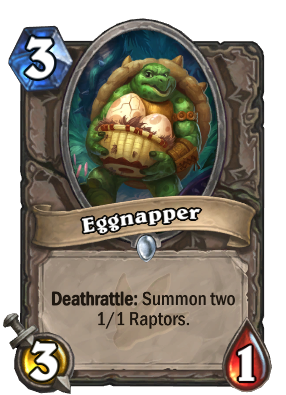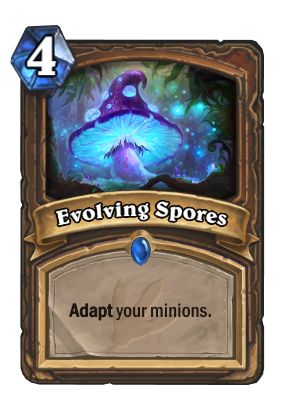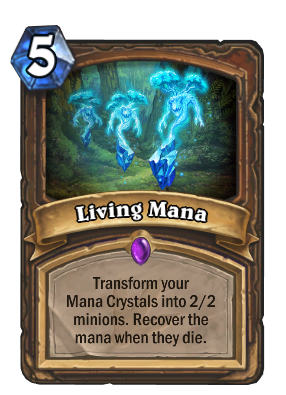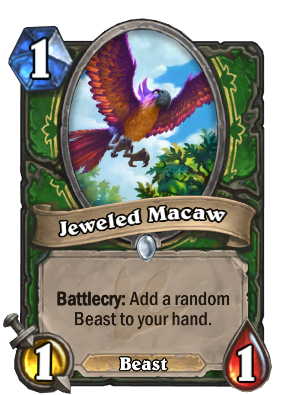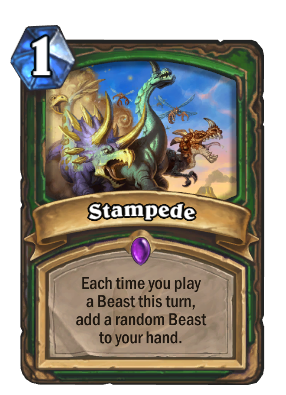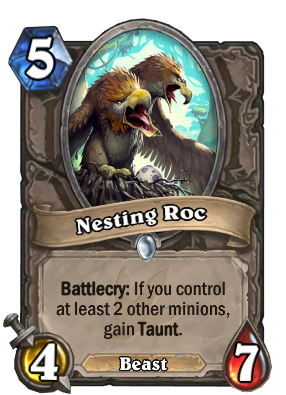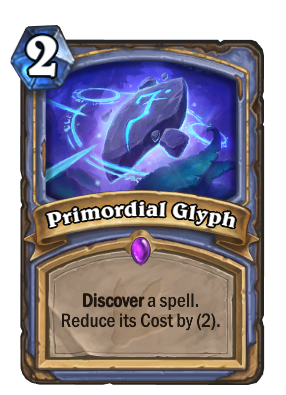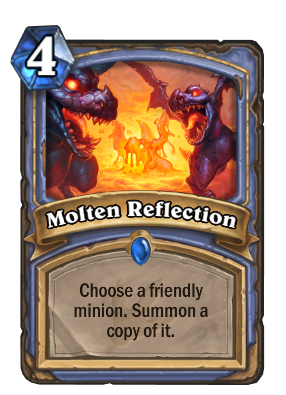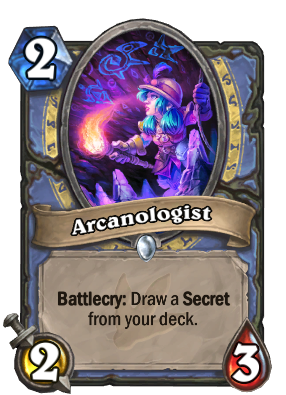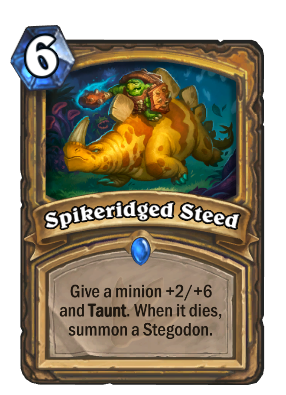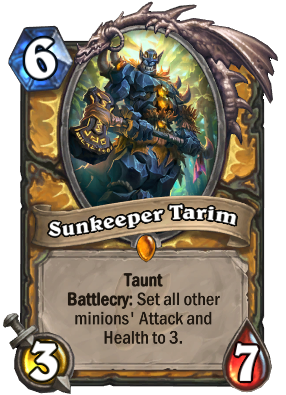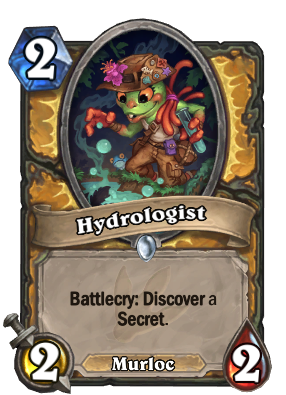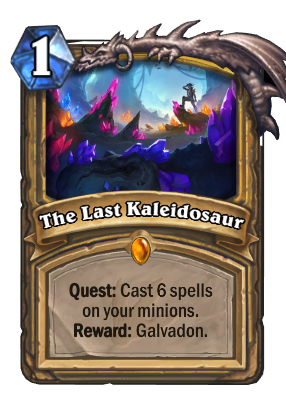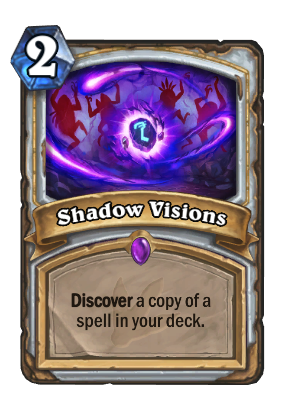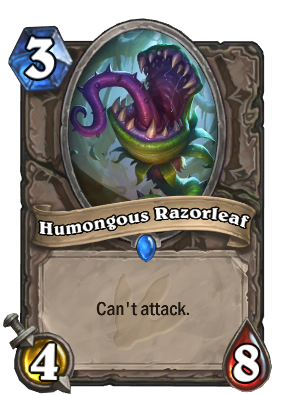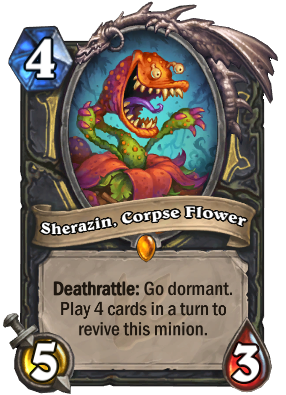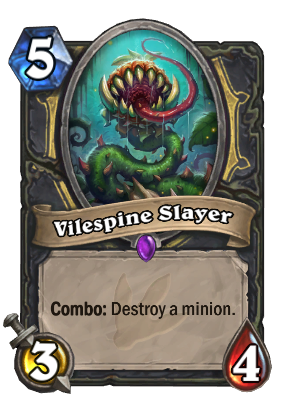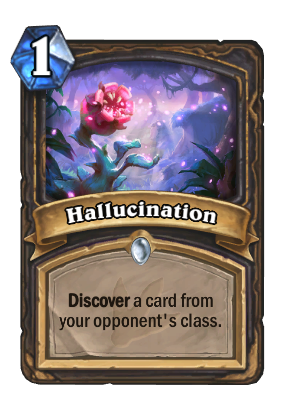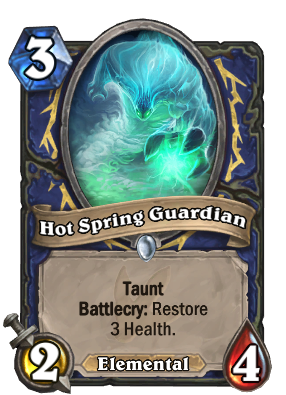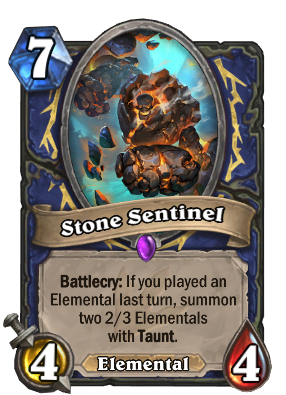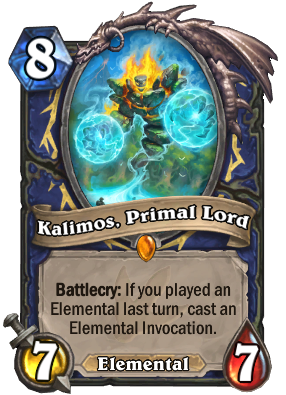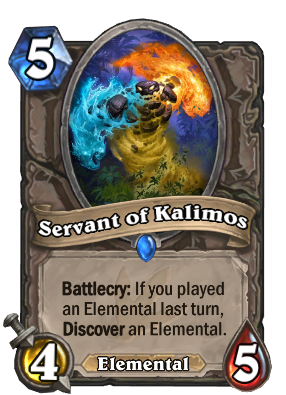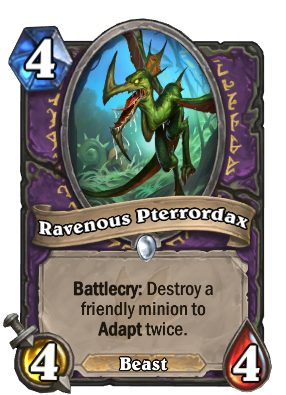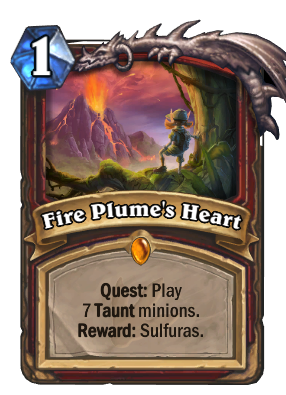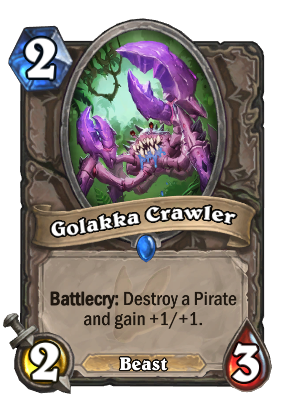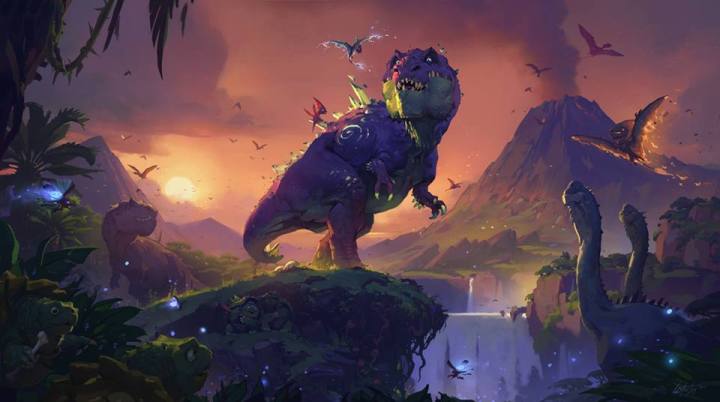
Journey to Un’Goro, Hearthstone’s latest expansion, has definitely achieved that shake-up. Although many in the community are voicing legitimate concerns about the growing economic barrier to being competitive, the game’s design feels quite healthy in a vacuum, with every class exploring a variety of apparently viable new deck archetypes. We’ve selected one new (or newly-revived) deck type for each class that we’ve enjoyed playing around with so far, in the hopes of inspiring your own deck-building experiments.
Token Druid
“Force of Nature” plus “Savage Roar” was once the most feared/hated combo in Hearthstone, allowing Druids to deal a whopping 14 damage for 9 mana and two cards, even from an empty board. This often went hand-in-hand with cards like “Violet Teacher” to flood the board with as many “token” minions (generated by a card effect rather than played as a card) as possible, maximizing the value of Savage Roar. Removing Charge from the treants created by Force of Nature killed that plan, however, forcing Druid decks to find new ways to win.
Un’Goro has brought token druid back, however, and it now rivals “Pirate Warrior” in its aggression (in fact, if often includes the typical pirate package for cheap aggro minions, and the value of “Patches” summoning himself). “Eggnapper” is showing up frequently in new deck lists thanks to its aggressive stat line and a deathrattle that leaves behind two 1/1 raptors. “Living Mana” is a new and interesting way to generate tokens, leaving your opponent the interesting decision of denying you minions or mana. “Mark of the Wild,” Savage Roar, and the more recent “Mark of the Lotus” will buff up all of the minions you generate, working especially well with Violet Teacher. “Evolving Spores” also adds flexibility as the only way to apply the new Adapt mechanic to your entire board no matter what kind of minions you have.
Mid-range Hunter
Hunter was arguably in the weakest position of any class by the end of the Mean Streets of Gadgetzan meta. Once the premiere “aggro” class, cards like Patches the Pirate and “Spirit Claws” allowed Warrior and Shaman to “go face” — ignore the opponent’s board and simply attack them directly — earlier and more efficiently than Hunter, and the class lacked powerful late game tools to make up for it (especially after Blizzard nerfed the infamous “Call of the Wild” card).
Synergy with Beast-class minions has always been an important aspect of the Hunter dynamic, and the dinosaur-themed Un’Goro expansion introduced a huge number of beasts into the game, which has helped push a midrange, minion-focused Hunter strategy back into viability. Barring Deathrattle synergies, the minion-summoning “Jeweled Macaw” is a strictly better version of “Webspinner,” which used to feature in most hunter decks, since it gives you another beast immediately on playing it. It works especially well with “Stampede,” which similar to “Lock and Load” but for Beasts. “Nesting Roc” adds crucial midgame support, since 4/7 for 5 mana is a great statline, and with cards like “Alleycat” and “Rat Pack,” Hunter has an easier time than most classes keeping two minions on the board to trigger its taunt. Crucially, this is a deck that can be quite strong without strategies that revolve around specific legendaries or epics, which has unfortunately become more and more difficult as the meta develops.
Exodia Mage
The most recent round of changes to the Standard format dealt a brutal blow to Freeze Mage decks, which have been a common construction since the beginning of the game, by removing one of its win conditions in “Ice Lance.” Blizzard’s Team 5 has provided another, more dramatic route to one turn kills with the quest card, “Open the Waygate.” Casting six spells that didn’t originate in your deck, which is easy enough to find with cards like “Cabalist’s Tome” or the new “Primordial Glyph,” gets you a direct reprint of a classic Magic card, “Time Warp,” which lets you take a second turn. The ability to take two turns obviously opens the door to several game-winning combos. Players have taken to calling decks built around Time Warp “Exodia Mages,” in reference to a Yu-Gi-Oh combo that just required assembling a particular combination of cards to immediately win. Thus far, people have generally been doing this either with “Arcane Giants,” or by using “Molten Reflection” to clone “Sorcerer’s Apprentices” a few times and then dropping “Archmage Antonidas” to spam infinite Fireballs.
Non-combo mage decks have been running “Arcanologist,” an understated early minion that pulls secrets for you without being as overpowered as “Mad Scientist.” Many mages are laddering with standard freeze or aggro burn lists that don’t slot any new cards besides the “Arcanologist,” but the new Elemental minion class slots in nicely as well, with “Water Elemental” being among the class’ stronger basic cards.
Mid-range Paladin
The Paladin quest card, “The Last Kaleidosaur,” hasn’t really taken off in the competitive meta yet, in large part because its reward is a single creature, leaving it vulnerable to hard removal effects like “Hex,” “Polymorph,” or “Assassinate,” depending on what adaptations you pulled. The class in general seems to have gotten a boost, however, with several new cards that feel like they could be flexible staples in a wide range of Paladin decks.
“Hydrologist” feels weak for its cost, but a 2/2 Murloc for two mana that nets you a card is nothing to sneeze at. Plus, it turns out that Paladin secrets are much more useful when you don’t need to dedicate a deck slot to them and can instead discover them situationally. “Getaway Kodo” also helps raise the stock of Paladin secrets in general, playing especially well with the class’ three legendary taunt minions, doubling their utility. Speaking of those legendaries — “Tirion Fordring,” “Wickerflame Burnbristle,” and the new “Sunkeeper Tarim” — the fact that Discover effects favor class cards so heavily means that “Stonehill Defender,” which is showing up in a lot of classes, is an absolute powerhouse for Paladins that only have legendary in-class taunts minions. Lastly, “Spikeridged Steed” is a phenomenal value for a single card, being played as a two-of in virtually every Paladin deck we’ve encountered for the last few weeks.
Purify Priest
“Purify” was universally panned on its release in the One Night in Karazhan adventure. Barring the edge case of purging enemy debuffs, paying two mana for the privilege of silencing a friendly minion and drawing a card felt like a cruel joke against a class that had been struggling (until “Drakonid Operative” brought Dragon Priest roaring back). Un’Goro introduces two cards that made a deck built around Purify not only viable, but competitive.
“Ancient Watcher” was previously the best target for Purify, as a 4/5 minion for 2 mana with the drawback “Can’t Attack,” which can be silenced to get a beefy, vanilla minion that’s well ahead of the curve. “Humongous Razorleaf “has joined it as an even more overstated minion (4/8 for 3) with the same drawback, doubling the number of early minions that take advantage of the deck’s core synergy. “Shadow Visions,” a 2-mana spell that discovers a copy of a spell from your deck, pushed it over the edge, providing added consistency to find those silencing spells or “Divine Spirit”/”Inner Fire” combo pieces when you need them. “Radiant Elemental” is the Priest version of the Mage card “Sorcerer’s Apprentice,” but with more durability, making it a strong backbone card for any spell-heavy Priest deck.
Miracle Rogue
The Rogue quest, “The Cavern Below,” was easily the most hated card of the set within the first few days of Un’Goro’s launch. Undervalued before launch, the community was collectively shocked by how easy it was to complete the quest very quickly, unexpectedly making “Stonetusk Boar” one of the most feared cards in the meta. It’s still very likely to be what’s in store when you face a Rogue, but the quest’s prominence has died down slightly as people have learned to play around it.
Miracle Rogue has been around since the game’s earliest days, and despite losing “Tomb Pillager,” “Azure Drake,” and “Conceal” in standard play, it remains a strong option with a few of the new cards worked in. “Vilespine Slayer” is a fantastic tempo card, since it both removes an enemy minion and gives you one of your own. “Hallucination” fits into the class theme of gaining random cards from your opponent’s class, but as a one-mana spell it fits perfectly into combos and the “Gadgetzan Auctioneer” draw engine. Lastly, the new legendary, “Sherazin, Corpse Flower,” is a real workhorse, being relatively easy to revive in a miracle deck and dealing heavy damage or absorbing a lot of removal over several lives, assuming it doesn’t get hit with Hex or Polymorph.
Elemental Shaman
Shaman was generally agreed to be in the strongest position going into Un’Goro, so many players worried that Shaman would just snowball any new toys into continued dominance of the competitive meta. Fortunately, the loss of “Tunnel Trogg” and “Totem Golem” dealt a serious blow to Shaman’s oppressively aggro early game, leaving room for new archetypes to develop.
In addition to new cards, Un’Goro introduced a major retcon to the existing cardpool with the Elemental tribe joining Murlocs, Beasts, Mechs, and Dragons. Shaman already has the powerful “Fire Elemental” in its basic set, and the addition of “Hot Spring Guardian,” “Fireplume Harbinger,” and “Stone Sentinel” gives Shaman the best curve for focusing purely on Elementals. The real kicker, however, is the new legendary, “Kalimos, Primal Lord,” who isn’t the game-breaking powerhouse some people thought he might be, but is nevertheless seriously powerful and flexible. “Servant of Kalimos” works especially well for Shaman, since Discover effects favor class cards, making multiple Kalimoses (Kalimoi?) not unreasonable.
Handlock
The Warlock quest “Lakkari Sacrifice” has proven to be one of the least impactful, so the discard-focused Warlock (or “Discolock”) hasn’t quite taken off like some thought it would. The reward just isn’t quite potent enough, and getting the most out of your discard effects can be quite fiddly, so it struggles against more consistent decks. With “Reno Jackson” having rotated out, Warlocks are now returning to the classic “Handlock” archetype, which uses the Lifetap hero power to snowball card advantage and always have the right answer to any board state in hand. The only new card from Un’Goro that’s been appearing consistently, however, is again the Humongous Razorleaf, since its younger brother the Ancient Watcher was likewise played in Handlock previously. Both are played in conjunction with “Sunfury Protector,” “Defender of Argus,” and “Faceless Shambler” to make large, under-costed taunt minions.
Warlock’s other classic archetype, Zoo (which floods the board with small minions to make efficient trades) received a few new toys as well. “Ravenous Pterodax” is Warlock’s version of the Adapt mechanic, sacrificing one of your many cheap minions to adapt twice, which can lead to some powerful combinations (such as the much-maligned 4-mana 7/7). “Devilsaur Egg” is the bigger brother of the Dragon- and “Nerubian Egg” cards, which have been Zoo staples at various times, and are all great buff and Taunt targets like the Razorleaf.
Taunt Warrior
Blizzard pushed a Taunt-focused Warrior build in Mean Streets of Gadgetzan with “I Know a Guy” and “Stolen Goods.” Without any real endgame other than slowing the game down, however, it didn’t take off until we got the Warrior quest, “Fire Plume’s Heart.” Summoning seven taunt minions nets you “Sulfuras,” a 4/2 weapon that changes your hero power into “Deal 8 damage to a random enemy,” essentially transforming you into “Ragnaros” (which has recently rotated into Wild, incidentally). That’s an extremely powerful win condition that pairs perfectly with building up a wall of Taunt minions to protect you while you rain down destruction.
“Bloodhoof Brave” and “Alley Armorsmith” are staples, joined by “Direhorn Hatchling,” which counts as two since it shuffles an overstated taunt into your deck when it dies, and “Tar Creeper,” a neutral elemental with Taunt that’s ending up in virtually every class. Pirate Warrior is still alive and well, and probably more prominent than Taunt Warrior on the ladder. The only card from the new set showing up in those lists, however, was ostensibly designed to suppress them: “Golakka Crawler,” which is most consistent in a deck where you can feed it your own pirates.
